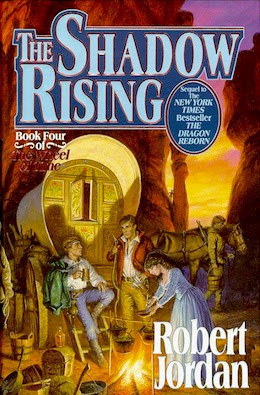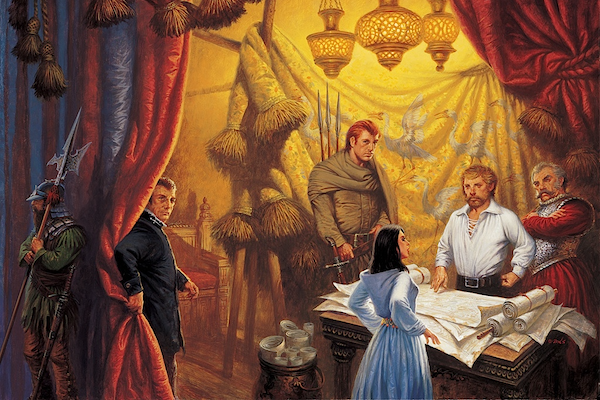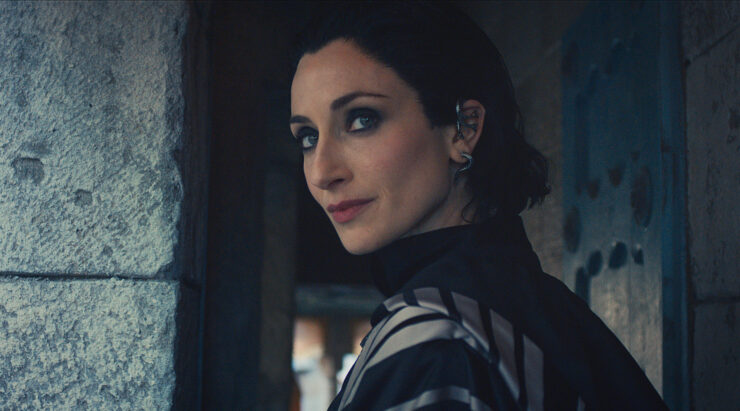Greetings, Professors! Shall we Redux a Wheel of Time Reread? Excellent!
Today’s Redux post will cover Chapter 28 of The Shadow Rising, originally reread in this post.
All original posts are listed in The Wheel of Time Reread Index here, and all Redux posts will also be archived there as well. (The Wheel of Time Master Index, as always, is here, which has links to news, reviews, interviews, and all manner of information about the Wheel of Time in general on Tor.com.)
The Wheel of Time Reread is also available as an e-book series! Yay!
All Reread Redux posts will contain spoilers for the entire Wheel of Time series, so if you haven’t read, read at your own risk.
And now, the post!
Before we begin, a reminder that the format of the Reread Redux has changed: from now on I am only going to be commenting on chapters in which my reaction has changed significantly from before, based on the knowledge I had at the time.
Though again I am picking up from where the last post left off, so again, doesn’t apply. It will next time, though.
But in the meantime, onward!
Chapter 28: To the Tower of Ghenjei
 Redux Commentary
Redux Commentary
Then something glittered ahead, sparkling in the sun, a tower of metal. His quarry sped straight for it, and vanished. Two leaps brought Perrin there as well.
Two hundred feet the tower rose, and forty thick, gleaming like burnished steel. It might as well have been a solid column of metal. Perrin walked around it twice without seeing any opening, not so much as a crack, not even a mark on that smooth, sheer wall. The smell hung here, though, that cold, inhuman stink. The trail ended here. The man—if man he was—had gone inside somehow. He only had to find the way to follow.
Stop! It was a raw flow of emotion that Perrin’s mind put a word to. Stop!
[…] You chase Slayer, Young Bull. He is here in the flesh, and he can kill.
Ah, the ever-mysterious Luc-Isam Collective, aka Slayer. Got all the way to the end of the series without ever completely learning his story, as it turned out. But the end of the series did sort of indirectly confirm my theory in the original commentary, which was that Slayer had no connection to the Finn, and did not in fact go inside the Tower of Ghenjei in this chapter, as Perrin thought, but instead merely led Perrin there as a hopefully deadly distraction. It’ll never be a hundred percent confirmed for sure, of course, because as I said the series as a whole never deigned to fully explicate to us all the ins and outs of Slayer’s personal history, but the lack of any further mention of a connection between the two (that I can recall, anyway) does seem to generally discredit the possibility.
Ergo, maybe Slayer and the Finn were total bros off-screen, but I tend to doubt it. I’m pretty sure Slayer leading Perrin to the Tower of Ghenjei was on par with leading him to a convenient pit trap that someone else built, just on the off-chance that Perrin would be stupid enough to fall into it.
Which, it must be said, he almost was. Although given Mat’s Moiraine-rescuing adventures in TOM, I’m not actually sure whether it would even be possible to get into the Tower without a handy ashanderei to do it with. Granted, Birgitte seems to think there is a way, and later tells about how one of her incarnations died inside, but as far as I recall she never got more specific on how exactly that version of her got in. So, in conclusion, dunno. Maybe it’s dangerous just to even be in the general vicinity of the thing.
I joked in the original post that Tel’aran’rhiod might as well be Old Tongue for “Infodump”, especially in the earlier books, and that is… still true. Heh. But, it was concurrently an excuse to introduce all kinds of wonderful fun mythological/historical references to the narrative, so that’s all right. And this chapter contains what is still one of my favorite references: the source of the name for the Tower of Ghenjei. Which is The Tale of Genji, generally considered to be the earliest work that qualifies as a novel, and which was written over a thousand years ago by a Japanese noblewoman known as Murasaki Shikibu. And in a spectacular example of the Baader-Meinhof phenomenon, a friend of mine just linked me to Anita Sarkeesian’s lovely tribute to her and her amazing achievement. The video’s less than four minutes long and well worth watching.
Aside from that, Birgitte also provides us with even more references:
“The tower? It is a doorway, archer, to the realms of the Aelfinn and the Eelfinn.” She said the names as if he should recognize them. When he looked at her blankly, she said, “Did you ever play the game called Snakes and Foxes?”
“All children do. At least, they do in the Two Rivers. But they give it up when they get old enough to realize there’s no way to win.”
“Except to break the rules,” she said. “ ‘Courage to strengthen, fire to blind, music to daze, iron to bind.’ ”
“That’s a line from the game. I don’t understand. What does it have to do with this tower?”
“Those are the ways to win against the snakes and the foxes. The game is a remembrance of old dealings. It does not matter so long as you stay away from the Aelfinn and the Eelfinn. They are not evil the way the Shadow is evil, yet they are so different from humankind they might as well be. They are not to be trusted, archer.”
Oh, so much yummy reference, it does my heart good. The ‘Finn, of course, are a play on the Faeries/Fae/Sidhe of Celtic mythology, which even the most casual fantasy reader has undoubtedly run into in any number of incarnations. The Aes Sedai are a more direct riff on the name, but the Aelfinn and Eelfinn are definitely the more similar in character to the Celts’ conception of the fae—most obviously, of course, in their aversion to iron, their susceptibility to music, and their general alien tricksiness. The Sidhe were even divided into two factions or Courts, the Seelie and Unseelie, and lived in what the Celts totally would have called an alternate dimension if they’d had the vocabulary for it, which could only be accessed by certain significant (and tricksy) ingress points.
As for the game of Snakes and Foxes, I probably do talk about it later, as I say in the original post, but even though I’m absolutely not going to track it down right now, I’ll bet you I said something about Chutes and Ladders, because that’s definitely what the game instantly made me think of. Except you can actually win at Chutes and Ladders, of course. Although as someone who can attest to this, thanks to certain young nephews who shall remain nameless, it can take unbelievably frickin’ long to finish, it can be won, so the analogy isn’t perfect. So maybe it’s more like Chutes and Ladders combined with Tic-Tac-Toe, or some other similarly unwinnable game that teaches you the futility of global thermonuclear war is basically designed to torture parents and/or child-adjacent adults. Yaaaaay.
Fun fact That I Did Not Know (Or Possibly Just Forgot) Until I Googled It Just Now: The game Chutes and Ladders, as commercialized by Milton Bradley in the States, is actually based on an ancient Indian board game called Snakes and Ladders, which means my association of the American game with Jordan’s Snakes and Foxes was absolutely not an accident. Though Jordan’s version seems to throw out the inherent morality aspect of the game in its various real-world incarnations in favor of, well, making it match up with his version of the Sidhe, who are not so big on that whole morality thing. The only “moral” of Snakes and Foxes, therefore, seems to be that the only winning move is not to play. How about a nice game of chess?
(Okay, I know. But I couldn’t resist!)
Aand I had intended to do another chapter, but I’m not sure yet where I want to pick up again after this, so instead of being arbitrary with it, I’m going to stop here. Have a week or two, chirren, and I’ll see you again Tuesday after next!















The game always sounded like Nine Men’s Morris or Fox and Geese (Wikipedia article under “Fox Games”) to me.
I am curious, what was supposed to be the “Price” one had to pay in order to get the 3 things asked for in the Finn world?? Mat didn’t ask for anything and he died, so what did others have to give up for their 3 things?
You have to negotiate the price, so it’s different every time, so long as you and the Finn agree to it. Matt asked for all three things without first negotiating a price, because he didn’t know what he was doing, so they named their own price.
I was always a little puzzled by Slayer’s guiding Perrin to the Tower as well, but I guess it was as you say: a trap to lead Perrin into, as well as a useful info dump on the Finns to plant seeds for later in the story.
IIRC, Mat did not use the ashanderei to get in to the Tower, he merely used it as an emergency exit when he left. I believe he learned from Brigitte the proper way to get in, something like drawing a triangle with wavy lines through it with a bronze dagger(?). So there are definitely proscribed ways to get in and out of the Finn’s domain outside the ashanderei and the Ter`angreal doorways.
You don’t need the ashandarei to get into the Tower, only to get back out.
I associate the name more with Gehenna, it doesn’t have anything to do with the Genji monogatari except a phonetic similarity.
It always gives me chills when we dissect how these things come together. Snakes and Foxes = Celtic mythology… Tower of Ghenjei = Coolest Japanese Female Author ever… just so amazingly cool. He was so well-versed in literature it boggles my mind. And it’s taken an entire fandom just to keep up with him.
WAIT – the Reread Redux is still happening?!?!? Big non-sparkly YAY.
This hasn’t been showing in my newsfeed, and I haven’t had time to visit Tor.com for a few months. Actually, it stopped appearing about the time the Movie Rewatch of Great Nostalgia started, so I was afraid it had fizzled out.
Anyway – yay! And I have posts to catch up on! And just in time to give me something to think about other than ridiculous and depressing U.S. electoral politics…
One question…with the format change, can you tell us what sections you’ll be commenting on next time?
Although I have no textual evidence to support this, I believe that Perrin could not enter the Tower of Ghenjei in the World of Dreams. As with an Ogier stedding and Rhuidean (before Rand destroyed the protections), a dreamer could not access the Tower of Ghenjei. This is my theory and I am sticking with it — at least until somebody comes up with a better theory :) .
Thanks for reading my musings.
AndrewHB
Iirc, you draw the triangle and the wavy lines with a bronze knife. The size of your triangle determines the size of the opening, so after Mat drew the first time, he had to redraw a big one.
I look forward to reading this post, but what happened to part 5? Can’t seem to find it anywhere!
I have long wondered if there were some lost elements to the rules of Snakes and Foxes, relating to the rhyme. Does every player get one use of each element to defeat a snake or fox that they run into? Is that the only way that it is mathematically possible to win?
Yeah, I want to know more of Slayer’s backstory. Mostly because it involves the Blight.
“Tower Ghenjei” always made me think of the Tale of Genji. It’s kind of cool to know that this was a deliberate reference. I don’t see any similarity between them that would merit it, but I haven’t read the latter.
The tower is 200 feet high and “forty thick.” Does that mean it’s 40 feet in diameter?
On what occasion was it good that Olver wasn’t in charge of NORAD?
@2 Each person negotiates their own price (presumably very carefully)
ETA quote:
Shadow Rising CHAPTER: 24 – Rhuidean
“Wise to ask leavetaking, when you set no price, no terms.” “Yet fool not to first agree on price.”
@9 – It looks like Part 5 wasn’t tagged correctly so it didn’t get added to the index. It should be fixed now. Thanks!
I don’t know if there’s an easier way, but when I don’t see an article in the feed, I plug the new date and part # into the url. That usually works fine.
@10, my theory on that snakes and ladders as played already takes into account that you’re using iron, music, etc. And you still can’t win. Or, rather, there is only some infinitesimal chance of winning–it’s easy to imagine a game based on chance with only like a 1 in a 1,000,000 probability of winning. The whole thing does have a morale–don’t mess with the ‘finns. Unless, that is, you think you’re extremely lucky :-P
@1 SPC: That’s exactly what I envisioned based on the description of the gameboard. I am not certain, but isn’t Fox and Geese also very hard to win?
@2 Lancer: Based on the way the Eelfinn act, I would think the price must always be for preserving your life, otherwise they’ll try and take it automatically. Although without a means to escape (the ashandarei) or a way to get back to an outer wall to use the bronze knife/get back to the redstone doorway, I’m not sure making sure they don’t kill you is enough. Considering the price Mat ends up giving up is an eye, maybe as long as you give up something like that, you get to live? Also, the Aelfinn escorted Mat back to the doorway in Tear (and presumably did the same for Rand and Moiraine) because of the covenant; presumably the Eelfinn would have done the same, if Mat had paid a price other than his life. If you don’t use the doorways though, all bets are off.
@@.-@ birgit: Which is funny, since Jehannah, capital of Ghealdan, is nowhere near the tower nor does it ever get visited in the series!
@7 AndrewHB: That feels right to me too, although being based on the Fae it’d be odd if the Finn didn’t have some tie to the World of Dreams. (Though the tower being there is just due to TAR reflecting reality.) On the other hand, why would Slayer lead Perrin there if he could never go inside and become trapped? On the gripping hand, Slayer may not know it can’t be entered (he’s hardly the expert on TAR he might claim to be–the only baddies who seem to know about the Finn are Ishamael and Lanfear; Moghedien never mentions them that I can recall). So he could have just led Perrin there hoping it’d get rid of him but not knowing. Then again, Birgitte seemed to think Perrin could go in and get trapped, so…
Re: the post–I’m glad Leigh mentioned the two courts of the Fae, otherwise I would have. Particularly in the fact that while the shorthand for them is usually “Seelie=good, Unseelie=bad” the truth is, as was noted in the Kitty Norville series, neither one is really that good. To use the TV Tropes term (and reflective of Birgitte’s comment that they are not evil like the Shadow but so different they might as well be), they have Blue and Orange Morality. What they do and why they do it is inscrutable and nonsensical by human morality, they clearly don’t care for mortals other than in what they can give them (emotions, memories, fate itself), and if they do things that help people or seem “good” it is always for their own reasons. As proof, while it’s the Eelfinn who nearly killed Mat in Rhuidean, when he returns in ToM and neglects to make sure both races cannot harm him, it’s the Aelfinn who almost kill them all (and do kill Noal).
I also want to mention again, since it was buried in a couple of my previous posts, that using the Old Tongue dictionary in the Companion reveals Sindhol translates to Neverland. That is even more appropriate, since in the original Barrie novel, Peter Pan was far more cruel, mercurial, and beyond human morality–very Fae-like. Plus of course there’s the whole “no one ages or grows up” thing which is in keeping with the way time usually runs very slowly or stands still altogether in Fair Folk realms (e.g. the Twlwyth Teg, Rip Van Winkle).
Not many other thoughts, though I do love Perrin’s talk with Gaul about his eyes. Also Gaul calling Perrin on his “yup, we’re totally just farmers, blacksmiths, and shepherds, rly trufax” spiel really losing its credibility. And yes, seeing Perrin leaping around from mountain to mountain is as fun as Egwene flying in Tanchico! Too bad that while his wolf dream visits remain adventuresome (unlike Egwene, who uses TAR for information gathering/sharing, fast travel, and dream training up until ToM), they stop being fun once Slayer really gets involved. Well, until he learns how to kick his ass, then it’s fun again!
As always, Perrin’s wolf dream visions are awesome. As much as Egwene’s dreams usually ended up being more relevant to the story (they’re the only ones we ever see either related to other characters, pondered and interpreted, or even attempted to either be averted or brought to pass), I always thought Perrin’s visions seemed more visceral and usually showed very critical things indeed. Case in point here: Rand at Rhuidean is obviously incredibly critical to the whole rest of his character arc, Mat’s choice is really what wins the Last Battle for the Light (since it leads to both Moiraine’s rescue and him being the great general they need), and it’s even very important for Egwene to learn dreamwalking from Amys (plus the whole White Tower crumbling bit obviously references the coup and the Black Ajah). The only one that arguably isn’t as important is the one in Tanchico…although considering that little adventure ends up leading to a) Moghedien’s enmity and capture and all that comes of it, including Nynaeve saving Rand, and by proxy Mat and Aviendha, from Rahvin b) the Domination Band and how key that is to Rand’s nadir and epiphany and c) Egeanin’s friendship which both makes the whole Mat/Tuon thing possible and is pretty damn important to Egwene and Logain during the Last Battle…yeah, that one may actually be pretty significant after all.
Speaking of significance, Birgitte and everything she says. God, I love her. ^_^ I do still wonder why Hopper didn’t see her; was she hiding herself from him? Does it have something to do with the prescripts, and her being a Hero of the Horn? Or is it because she’s not a thing of the wolves? (Although Hopper is aware of and can see Lanfear in AMoL.) I’m going to go with Hero of the Horn connection, although it wouldn’t surprise me if Birgitte could break the prescripts selectively, appearing to Perrin (and later Elayne and Nynaeve) because she wanted to but staying invisible to all others.
I also want to know how Birgitte knows of wolfbrothers; did she ever work with some, or even have them as friends and companions? That sounds like a very cool story. Also…Slayer is an old evil too? What does that mean? I mean, Isam was a Darkfriend and he works for the Shadow but she seems to be suggesting something more, like Aginor recognizing the Shadar Logoth dagger as an old enemy. Is there something about the way the Dark One created Slayer that partakes of a different old evil we don’t know about? Gah, the not knowing!
Well at least I think it’s safe to say Birgitte’s wry comment proves exactly why she spoke to Perrin and said as much as she did–not only is he ta’veren, as we see in this very book he’s the one of the boys whose Pattern-twisting most closely relates to charisma and influencing other people. Even Heroes of the Horn it seems. Though I do think she also recognized him from Falme (as he almost recognized her) and that’s why she initially spoke. That and, as we later learn, her very personal reason for fearing the Finn and wanting to save others from that fate.
Thank you for this reference! I totally forgot about it in the original reading. But I ran across the name Lady Murasaki in Bujold’s book Cryoburn. It sounded familiar, but I failed to look it up. The kids named a Wolf spider Lady Murasaki because “That’s the name of the oldest lady I know.” Sneaky… I loved the video.
cdrew147 @14: If I cannot find a particular article and I know the author, I click on the author’s name in another article he/she has written. You get a list of all the articles he/she has written. That is how I would find Part 5 of this Reread Redux.
Thanks for reading my musings.
AndrewHB
The video about Murasaki Shikibu mentions that women were known by nicknames, but it doesn’t explain the author’s “name”. Shikibu is a court rank. Murasaki (= purple) is a character from the book, Genji’s favorite lover and second wife (The book is about his many relationships with different women. He had 3 wives and many other lovers. His first wife is the only woman who didn’t love him.). From a modern perspective it is a problematic relationship: he adopted the girl and then married her. The book mentions that she isn’t happy when her stepfather suddenly beds her, but she has been raised to be the perfect wife and can’t really protest.
The women in the book don’t really have names, scholars simply refer to them by descriptions like “the third princess” (Genji’s third wife) or “the lady who lives in sixth street”. The hero is a son of the emperor and his favorite concubine (who was mobbed to death by his other women) and is adopted into the powerful Minamoto clan, which can also be pronounced Genji.
The book also contains a ghost story: Rokujō (the lady from sixth street, one of Genji’s lovers) becomes a jealous living ghost who possesses Genji’s (first) wife Aoi and maybe also other women he loves.
I also had the Chutes and Ladders board in my head. Although Snakes sound way cooler to me!
The lack of resolution/clarification on what Slayer was (and the purpose in creating him, and how) was always something that bugged me a bit but I know RJ had always said there would be loose ends. Neither Luc nor Isam were evil to start, correct? So were they ‘turned’ in some way? And hadn’t Gitara sent Luc out in the first place or am I mixing that up with Tigraine? I suppose in some say Slayer was necessary because through battling him Perrin learned the skills he did which allowed him to fight effectively in the dreamworld during the final battle, but Slayer always struck me as a cool but underutilized idea that doesn’t totally fit in the rest of the worldview. Kinda like Tom Bomadil…but with less ring a dong dillo-ing.
Gitara had Foretellings that made her send Luc and Tigraine away to their different fates. Elaida is the best example that those who have Foretellings don’t always understand them.
re: Part 5 – I also did not see a link to Part 5 so I didn’t know it had been posted. I just went to read it but the 30 comments are not visible. Is this a Tor issue or my computer issue? I can see the comments to this Part 6 post just fine.
@22 – it’s a Tor issue. There are intermittent problems since they changed websites with the way the scripts load comments. I would contact their help desk/webmaster (you can do so through the contact us link) because they’ve fixed it for me before but they probably need more examples to determine if there’s a widespread fix.
18. AndrewHB
Yeah, that’s what I do, too.
@20 Lisamarie: Yeah, as birgit said, Gitara gave Foretellings to both of them. She told Tigraine she had to go to the Waste and become a Maiden of the Spear, and couldn’t come back until the Aiel came to Tar Valon, or else it’d be the end of the world. She just told Luc he had to go to the Blight because it was fate/he’d find infamy/become legendary. (It is notable we got told pretty much the exact words for the Tigraine Foretelling, but only got hearsay and rumor for Luc’s.) No, neither of them were evil, although since Isam’s mother tried to take over Malkier for her husband and son and was working with a Darkfriend, I doubt he’d have turned out well if he stayed in that sort of company. And then he ended up growing up in the Town anyway, so.
I’ve theorized before that the reason Slayer was needed was for Perrin, because if he hadn’t existed Perrin never would have learned the wolfdream skills the Pattern needed. Considering what all he did there–teaching Egwene how to use TAR so she could defeat Mesaana, which in the end even turned out to help her come up with how to kill Taim and repair the Pattern, learning about dreamspikes so he could get rid of the one at the Black Tower thus allowing Androl and the others to save Logain and oust Taim, and of course being able to resist Lanfear’s Compulsion so as to save Rand and the others at Shayol Ghul–then yes I’d say Slayer enabling all of this certainly explained why the Foretellings were necessary. But I agree he was underutilized otherwise.
macster @16
She probably has at one point or another. Bear in mind, that the version of Birgitte Perrin is interacting with at this point has all her memories from all her incarnations.
On Snakes And Ladders/Snakes and Foxes:
I dunno about the lot of you but it’s always been Snakes and Ladders to me. As for Snakes and Foxes, isn’t the game board sort of spider web shaped?
AndrewHB @7
I think you can enter it in TAR the same way you do in the real world. What’s more the place within it where the Snakes and Foxes live exists in neither plane.
alreadymadwithSnakes @26: My first version was definitely Snakes and Ladders.